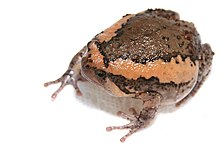Kaloula
|
Kaloula Temporal range: Miocene - Present,22.3–0 Ma |
|
|---|---|
 |
|
| Banded bullfrog, Kaloula pulchra | |
| Scientific classification | |
| Kingdom: | Animalia |
| Phylum: | Chordata |
| Class: | Amphibia |
| Order: | Anura |
| Family: | Microhylidae |
| Subfamily: | Microhylinae |
| Genus: |
Kaloula Gray, 1831 |
| Type species | |
|
Kaloula pulchra Gray, 1831 |
|
| Diversity | |
| About 17 species (see text) | |
Kaloula is a genus of microhylid frogs found in South Asia, Southeast Asia and East Asia. They are sometimes known as the Asian narrowmouth toads.
The genus currently has at least 18 species. Some sources recognize Kaloula macrocephala Bourret, 1942 as a valid species, whereas the Amphibian Species of the World treats it as a synonym of Kaloula pulchra. 5 new species have been described since 2000, and there are unnamed species yet to be described.
Kaloula pulchra, Kaloula picta, and Kaloula borealis are the most widespread and commonly found varieties, often living near human settlements.
Blackburn, et al. (2013) lists several Kaloula varieties that are likely to be new, previously undescribed species.
A molecular phylogenetic study by Mo et al. (2013) suggests that the only four Kaloula species found in China, namely Kaloula borealis, Kaloula nonggangensis, Kaloula rugifera, and Kaloula verrucosa, belong to a monophyletic group, termed the K. verrucosa group.
Blackburn, et al. (2013) consider Kaloula species endemic to the Philippines to form a monophyletic group, containing the species Kaloula walteri, Kaloula rigida, Kaloula conjuncta, Kaloula picta, Kaloula kalingensis, and Kaloula kokacii. Kaloula likely colonized the Philippines from Southeast Asia during the Late Miocene, and then radiated into different ecotypes.K. kalingensis and K. kokacii occupy niches as arboreal tree-hole frogs in northern and southern Luzon respectively, while K. rigida and K. walteri are ground frogs in northern and southern Luzon respectively. K. picta, which is a terrestrial ground frog, and K. conjuncta, which is scansorial (climbing) and prefers shrubs, have established themselves throughout the Philippine archipelago. K. picta as well as K. pulchra display the lowest internal genetic diversity, but also have widespread geographical distributions that may have likely occurred be due to human activity.
...
Wikipedia
